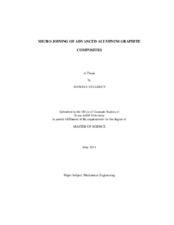Micro Joining of Aluminum Graphite Composites
| dc.contributor.advisor | Hung, Wayne | |
| dc.creator | Velamati, Manasa | |
| dc.date.accessioned | 2012-07-16T15:57:07Z | |
| dc.date.accessioned | 2012-07-16T20:23:32Z | |
| dc.date.available | 2012-07-16T15:57:07Z | |
| dc.date.available | 2012-07-16T20:23:32Z | |
| dc.date.created | 2011-05 | |
| dc.date.issued | 2012-07-16 | |
| dc.date.submitted | May 2011 | |
| dc.identifier.uri | https://hdl.handle.net/1969.1/ETD-TAMU-2011-05-9375 | |
| dc.description.abstract | Advanced aluminum graphite composites have unique thermal properties due to opposing coefficients of thermal expansion of aluminum and graphite. The thermal and mechanical properties of such composites are anisotropic due to directional properties of graphite fibers and their designed orientation. A joint with different fiber orientations would theoretically produce an isotropic material for thermal management. This paper presents results for welding and brazing of the composite using different joining techniques. Laser welding of Al-Gr composite showed that a power density above 30kW/mm2 gives a weld with microstructure defects. Also the laser beam melts the matrix and delaminates the graphite fibers. The molten aluminum reacts with graphite to form aluminum carbide (Al4C3). The joint strength is compromised when laser welding at optimal conditions to minimize the carbide formation. Also porosity and redistribution of graphite fibers is seen during laser welding. These defects prompt us to consider a low temperature joining. Brazing is considered since the low melting temperature of a filler material suppresses the formation of Al4C3 while minimizing pores and microstructural defects in the joint. Microstructural study and shear test are performed to analyze the joints. Shear strengths of brazed joints are determined to be 20-21MPa which is comparable to the composite shear strength (46.5MPa in x-y plane and 19MPa in z plane). The fracture surface is found to be mostly on the composite rather than in brazed material or along the interface. Also, the microstructural study showed no Al4C3 formation and minimal porosity in the brazed region. These results show a successful joining of the composite using laser brazing and resistance brazing methods. | en |
| dc.format.mimetype | application/pdf | |
| dc.language.iso | en_US | |
| dc.subject | Metal matrix composites | en |
| dc.subject | aluminum | en |
| dc.subject | graphite | en |
| dc.subject | welding | en |
| dc.subject | brazing | en |
| dc.subject | joining | en |
| dc.title | Micro Joining of Aluminum Graphite Composites | en |
| dc.type | Thesis | en |
| thesis.degree.department | Mechanical Engineering | en |
| thesis.degree.discipline | Mechanical Engineering | en |
| thesis.degree.grantor | Texas A&M University | en |
| thesis.degree.name | Master of Science | en |
| thesis.degree.level | Masters | en |
| dc.contributor.committeeMember | Price, Angie | |
| dc.contributor.committeeMember | Suh, Chii Der | |
| dc.type.genre | thesis | en |
| dc.type.material | text | en |
Files in this item
This item appears in the following Collection(s)
-
Electronic Theses, Dissertations, and Records of Study (2002– )
Texas A&M University Theses, Dissertations, and Records of Study (2002– )


